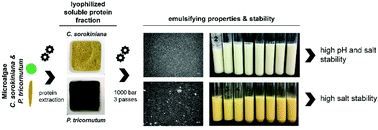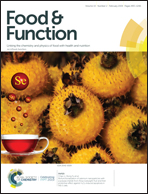Emulsifying properties of water-soluble proteins extracted from the microalgae Chlorella sorokiniana and Phaeodactylum tricornutum†
Abstract
This study investigated the formation and stability of emulsions with lyophilized water-soluble protein extracts from two different microalgae species. Lyophilized soluble protein extracts from Chlorella sorokiniana and Phaeodactylum tricornutum with a protein content of 39.2 and 37.2 wt%, respectively, were used. Drop-shape analysis showed them to have considerable interfacial activity at the oil–water interface. The application in emulsions, prepared by high-pressure homogenization (1000 bar, 3 passes, 5.0 wt% oil) further revealed that a concentration of 1.0 wt% soluble protein from Chlorella sorokiniana was sufficient to manufacture an emulsion with a monomodal droplet size distribution and a small volume based mean particle diameter (d43 = 232 ± 22 nm). Emulsions remained stable throughout 7 days of storage (d43,7d = 265 ± 4 nm). In contrast, 3.7 wt% of the respective proteins from Phaeodactylum tricornutum were needed to obtain a stable emulsion (d43 = 334 ± 12 nm and d43,7d = 325 ± 8 nm). Emulsions prepared with both algae fractions showed unusually high salt stabilities up to 500 mM of sodium chloride, with no appreciable changes in volume based mean particle diameter, appearance, or microstructure. Furthermore, model emulsions with soluble lyophilized proteins from Chlorella sorokiniana had a very high stability toward changes in pH (pH ≥ 5), whereas soluble proteins of Phaeodactylum tricornutum showed only a moderate pH stability with the smallest volume based particle size at pH 7.



 Please wait while we load your content...
Please wait while we load your content...